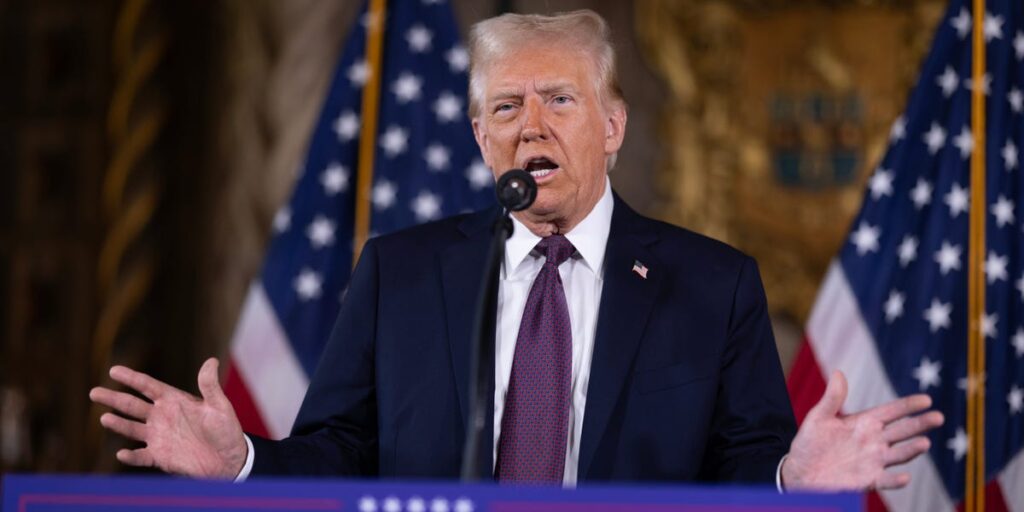- Donald Trump’s suggestion for increased NATO defense spending has divided European countries.
- Trump called for NATO members to raise defense spending to 5% of GDP.
- Many European NATO members have struggled to meet the current 2% defense spending goal.
Donald Trump’s suggestion that NATO members should allocate 5% of their GDP on defense has prompted mixed reactions in Europe.
The president-elect floated the figure — which is more than double the current target — at a press conference on Tuesday.
“I think NATO should have 5%,” he said. “They can all afford it, but they should be at 5%, not 2%.”
Currently, no alliance member spends 5% of GDP on defense.
NATO estimates showed Poland was set to lead the alliance in defense spending as a percentage of GDP in 2024, with Warsaw investing more than 4% of its economic output on defense. Estonia and the US followed, spending 3.43% and 3.38% respectively.
Trump’s remarks sparked dismay among some European officials.
Ralf Stegner, a member of Germany’s Social Democratic Party, wrote in a Facebook post that Trump’s comments were “delusional and truly insane.”
“Where are the resources supposed to come from to solve the real-world problems?” he said. “We have too much poverty, environmental destruction, civil wars, migration, and too few resources to combat this more actively.”
Speaking to reporters on Wednesday, Italian Defense Minister Guido Crosetto cast doubt on the feasibility of Trump’s proposal: “I don’t think it will be five, which at this time would be impossible for almost all nations in the world,” he said, per Italian news agency Ansa.
But Crosetto added that he did expect the target to be raised above 2%.
Italy was on track to spend 1.49% of GDP on defense in 2024, while Germany — which is gearing up for a snap federal election in February — was set for 2.12%.
For nations closer to Russia and its ongoing invasion of Ukraine, increasing defense expenditure may not seem like such a bad idea, however.
Warsaw has already signaled its support for Trump’s demand, with the Polish defense minister telling the Financial Times that Poland “can be the transatlantic link between this challenge set by President Trump and its implementation in Europe.”
In Estonia, the shared border with Russia has led to heightened tensions and an increasing focus on defense.
Reacting to Trump’s comments, Estonian Prime Minister Kristen Michal told Politico that it was the “message that Estonia has been advocating for years.”
“This is a clear signal to Putin that he should not dare to test NATO’s nerves and that we are prepared for it,” he said.
At a Northern Group partners’ meeting last year, Estonia’s defense minister urged allies to increase spending to 2.5% to counter the threat of Russian aggression.
Sweden, which has also increased defense spending since Russia’s invasion of Ukraine in 2022, also backed the call for increased spending.
“There is a broad consensus in Sweden that we need to invest more in our defense,” the country’s foreign minister, Maria Malmer Stenergard, said, per Politico. “US governments have long urged European countries to increase their defense spending and to bear more of their own defense costs. We share this view.”
Lithuania has also prioritized defense spending amid the growing Russian threat. Its president, Gitanas Nausėda, recently called on European countries to “show more support for the US global agenda” by increasing their share of the defense burden.
For his part, NATO Secretary General Mark Rutte has said Europe knows it must spend more on defense.
During a trip to Warsaw in November, Rutte praised Poland for its defense spending efforts, saying it sent “a clear message not only to our adversaries but also to the United States. That Europe understands it must do more to ensure our shared security. And that starts with spending more and also fielding more capabilities.”
Nevertheless, analysts say Trump’s 5% figure is unrealistic.
“Many European NATO countries are funding higher military spending through debt, cuts in other expenditure areas, and proposals to increase taxes,” Nan Tian, a senior researcher and program director at the Stockholm International Peace Research Institute’s Military Expenditure and Arms Production Programme, told Business Insider. “These existing increases would push military spending to a level about half of what Trump proposed of 5% of GDP, thus I don’t think this is a realistic target.”
“5% of GDP level would be higher than the same countries spent at the height of the Cold War,” Tian added.
Ruther Deyermond, a senior lecturer at King’s College London’s Department of War Studies, went further, calling Trump’s suggestion a “coercive tactic.”
“It looks as if the point of the 5% demand is for it to be unachievable – the intention seems to be that states will fail,” Deyermond wrote on X. “It’s a coercive tactic (pay up or your country gets it) that also signals that NATO is no longer a meaningful alliance.”
Read the full article here


